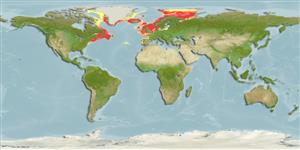Preferred temperature (ссылка
123201): 0.8 - 12.1, mean 7.8 °C (based on 1910 cells).
Phylogenetic diversity index (ссылка
82804): PD
50 = 0.5938 [Uniqueness, from 0.5 = low to 2.0 = high].
Bayesian length-weight: a=0.00407 (0.00305 - 0.00544), b=3.19 (3.11 - 3.27), in cm total length, based on LWR estimates for this species (Ref.
93245).
Trophic level (ссылка
69278): 3.6 ±0.0 se; based on diet studies.
устойчивость к внешним воздействиям (ссылка
120179): низкий, минимальное время удвоения популяции 4.5-14 лет (K=0.04-0.1; tm=6-7; Fec=12,740-25,000).
Prior r = 0.40, 95% CL = 0.26 - 0.60, Based on 3 full stock assessments.
Fishing Vulnerability (Ref.
59153): High to very high vulnerability (69 of 100).
🛈
Climate Vulnerability (Ref.
125649): Moderate vulnerability (38 of 100).
🛈
Nutrients (Ref.
124155): Calcium = 8.54 [4.15, 34.43] mg/100g; Iron = 0.178 [0.082, 0.506] mg/100g; Protein = 17.1 [15.1, 19.7] %; Omega3 = 0.376 [0.216, 0.633] g/100g; Selenium = 38.1 [13.6, 104.4] μg/100g; VitaminA = 6.68 [2.05, 21.68] μg/100g; Zinc = 0.675 [0.265, 1.313] mg/100g (wet weight); based on
nutrient studies. 